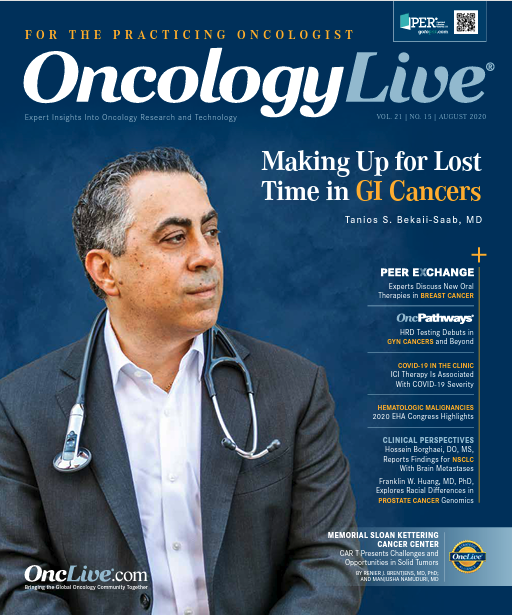Publication
Article
Immuno-oncology Agents Face Off in NSCLC
Author(s):
Investigators will pit 2 PD-1/PD-L1–pathway agents against each other in a bid to determine which therapy can confer the greatest survival benefit in patients with PD-L1–high, advanced non–small cell lung cancer.
Edward B. Garon, MD

Investigators will pit 2 PD-1/PD-L1– pathway agents against each other in a bid to determine which therapy can confer the greatest survival benefit in patients with PD-L1–high, advanced non–small cell lung cancer (NSCLC).
The phase 3 study (NCT03631706) will compare single-agent pembrolizumab (Keytruda) with bintrafusp alfa (M7824), a first-in-class bifunctional fusion protein, in 584 patients with stage IV NSCLC who do not harbor an EGFR or BRAF V600E mutation, an ALK translocation, or a ROS1 rearrangement.1 Patients must have tumor tissue that is less than 6 months old available for PD-L1 status assessment, which will be determined by central testing prior to the first dose of either the experimental or control therapy.
The rationale for testing bintrafusp alfa in this patient population stems from investigators’ push to identify a more potent immunostimulatory treatment intervention. “We have seen that PD-L1 inhibition alone leads to significant benefits, but there are other approaches that theoretically can enhance the effects of the immune system,” said Edward B. Garon, MD, principal investigator of the trial site at the University of California, Los Angeles.
Bintrafusp alfa is composed of 2 extracellular domains of TGF-βRII—also known as a TGF-β “trap”—fused to an anti–PD-L1 human IgG1 monoclonal antibody.2 The aim of using a bifunctional antibody is to increase efficacy above and beyond that achieved with individual therapies or combinations of individual therapies.
“Dual TGF-β and PD-L1 blockade is an alternative methodology that might offer promise to patients with PD-L1–high NSCLC,” according to Garon, who serves as an associate professor of medicine in the Division of Hematology/Oncology at the Geffen School of Medicine at the University of California Los Angeles. TGF-β promotes tumor progression via immune- and nonimmune-related processes. Consequently, obstructing TGF-β activity may lead to greater sensitivity to PD-L1–directed monoclonal antibodies.1,2
The study is based on the hypothesis that by blocking both immunosuppressive pathways in the tumor microenvironment, bintrafusp alfa has the potential to afford greater control of tumor growth than an inhibitor with a unifunctional mechanism, such as pembrolizumab.3 Investigators will evaluate progression-free survival (PFS) and overall survival (OS) as coprimary end points. (Figure).1 The cutoff for PD-L1 expression is 80%. “The 80% value for the antibody associated with [bintrafusp alfa] is similar to the 50% cut point with the more commonly used CC23 antibody. Therefore, the cutoff for this study is 80% using this test,” Garon said.
Figure. Bintrafusp Alfa Versus Pembrolizumab in PD-L1–High NSCLC

Early Signs of Efficacy
Bintrafusp alfa’s potential to restore and enhance antitumor responses in a localized and nonredundant manner is supported by data from an ongoing, global phase 1 study (NCT02517398) evaluating the agent as a second-line therapy in patients with advanced NSCLC. Tumor cell PD-L1 expression was immunohistochemically assessed; PD-L1–positive was defined as tumor staining greater than or equal to 1%, and PD-L1–high, 80% or greater.3
Efficacy and safety data presented at the 2020 American Society of Clinical Oncology Virtual Scientific Program demonstrated that bintrafusp alfa monotherapy induced durable responses and improved long-term survival in patients with advanced NSCLC, with a marked benefit in the PD-L1–high population.3
At the recommended phase 2 dose of 1200 mg every 2 weeks, the median OS was 21.7 months (12.2–not reached [NR]) in patients with PD-L1–positive disease; it was NR in individuals with PD-L1–high NSCLC (9.6-NR). The median duration of response was 18.0 months (95% CI, 4.2-23.5) and 63.6% of patients had responses that lasted at least 1 year. The overall safety profile remained consistent with what was seen in the earlier analysis, with no new safety signals or deaths, investigators said.3
An Expanding Armamentarium
Frontline treatment options for PD-L1–high advanced NSCLC include pembrolizumab, nivolumab (Opdivo) plus ipilimumab (Yervoy), and atezolizumab (Tecentriq) with or without bevacizumab (Avastin). These options, each of which can be given with or without chemotherapy, represent the possibility of first-line therapy with PD-1/PD-L1 inhibition with or without CTLA-4 blockade, Garon said.
“We have seen approvals for PD-1 and PD-L1 inhibition, and [the] combination of PD-1 inhibition with anti–CTLA-4 [agents]. As our treatments in advanced-stage non–small cell lung cancer improve, we will continue to move forward, and we anticipate an even greater expansion in what could be a better standard of care than what we have had in the past,” Garon said.
The study is currently recruiting across more than 100 sites worldwide.
References
- M7824 versus pembrolizumab as a first-line (1L) treatment in participants with programmed death-ligand 1 (PD-L1) expressing advanced non-small cell lung cancer (NSCLC). ClinicalTrials.gov. Updated July 2, 2020. Accessed July 9, 2020. https://clinicaltrials.gov/ct2/show/NCT03631706
- Ahn MJ, Barlesi F, Felip E, et al. Randomized open-label study of M7824 versus pembrolizumab as first-line (1L) treatment in patients with PD-L1 expressing advanced non-small cell lung cancer (NSCLC). J Clin Oncol. 2019;37(suppl 15):TPS9114. doi:10. 1200/JCO.2019.37.15_suppl.TPS9114
- Cho BC, Kim TM, Vicente D, et al. Two-year follow-up of bintrafusp alfa, a bifunctional fusion protein targeting TGF-β and PD-L1, for second-line (2L) treatment of non-small cell lung cancer (NSCLC). Poster presented at: ASCO20 Virtual Scientific Program; May 29-31, 2020. Abstract 9558. https://media4.asco.org/258/14762/190154/190154_poster_big_1.jpg
- Sater HA, Robinson J, Strauss J, et al. Spatial analysis of tumor immune microenvironment (TIME) in patients treated with bintrafusp alfa. Poster presented at: ASCO20 Virtual Scientific Program; May 29-31, 2020. Abstract 3070. https://meetinglibrary.asco.org/record/188598/poster










